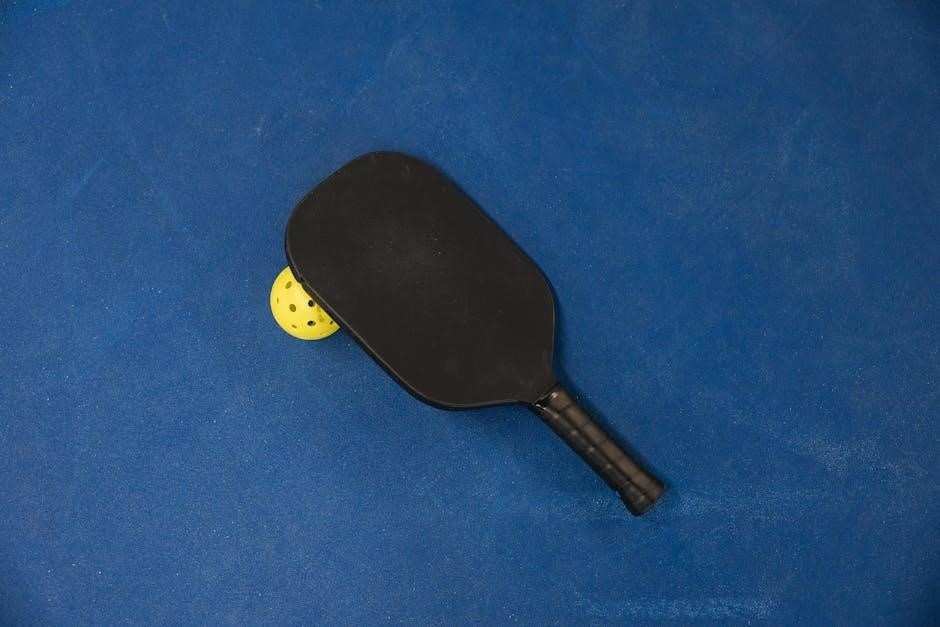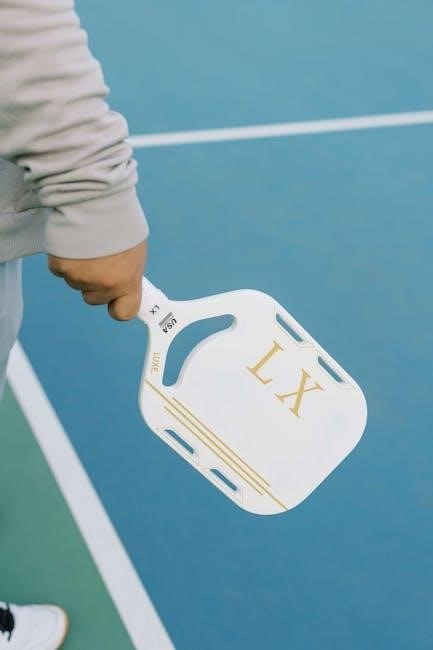Pickleball paddle weight significantly impacts performance, offering a balance between power, control, and maneuverability․ Paddles are categorized as lightweight, midweight, or heavyweight, each suited for different playing styles․
1․1 Why Paddle Weight Matters in Pickleball
Pickleball paddle weight significantly impacts a player’s performance by affecting power, control, and maneuverability․ A heavier paddle can generate more power but may reduce swing speed and lead to fatigue․ Lightweight paddles offer quicker swings and better control but may lack in power․ The weight also influences comfort and playing style, making it crucial to choose a paddle that balances these elements for optimal gameplay and personal preference․
1․2 Overview of Paddle Weight Categories
Pickleball paddles are categorized into three main weight groups: lightweight (below 7․3oz), midweight (7․3oz–8․3oz), and heavyweight (above 8․3oz)․ Lightweight paddles prioritize speed and control, ideal for quick players․ Midweight paddles offer a balance between power and maneuverability, catering to versatile players; Heavyweight paddles maximize power for strong hitters․ Understanding these categories helps players choose a paddle that aligns with their skill level, style, and performance goals, ensuring optimal gameplay and comfort․
Understanding Paddle Weight Categories
Pickleball paddles are categorized into lightweight, midweight, and heavyweight based on their weight, each offering unique benefits for different playing styles and preferences․
2․1 Lightweight Paddles (Below 7․3oz)
Lightweight paddles are ideal for players seeking speed and maneuverability․ Weighing under 7․3oz, these paddles enhance quick reflexes and fast exchanges, making them perfect for players who prioritize agility over raw power․ Their reduced mass allows for faster swing speeds, enabling sharp angles and precise shots․ They’re particularly favored by those with a focus on control and finesse, though they may lack the punch of heavier options․ Lightweight paddles are often preferred by beginners or players with shorter swings․
2․2 Midweight Paddles (7․3oz–8․3oz)
Midweight paddles, weighing between 7․3oz and 8․3oz, offer a balanced blend of power and control․ They suit a wide range of players, providing enough heft for solid shots while maintaining sufficient maneuverability․ This category is ideal for those who desire versatility, blending the responsiveness of lighter paddles with the strength of heavier ones; Midweight paddles are a popular choice among intermediate players and those seeking a well-rounded performance without sacrificing comfort or power․
2․3 Heavyweight Paddles (Above 8․3oz)
Heavyweight paddles, exceeding 8․3oz, are designed for players prioritizing power and stability․ They deliver strong shots and are often favored by those with slower swing speeds or those who rely on precise, forceful strikes․ However, their increased weight can reduce agility and swing speed, making them less ideal for quick exchanges․ These paddles are best suited for experienced players seeking maximum power and are typically used in competitive play where strength and impact are crucial․ Player preference and style heavily influence their use․

How Paddle Weight Affects Performance
Paddle weight influences power, control, and speed․ Lighter paddles enhance agility and quick reflexes, while heavier ones boost striking force, affecting overall gameplay dynamics and player strategy in pickleball․
3․1 Power vs․ Control: The Trade-Off
In pickleball, paddle weight dictates a trade-off between power and control․ Heavier paddles generate more power, enabling harder shots, while lighter ones offer precision and faster swings, crucial for net plays and quick exchanges․ Players must balance their style: those seeking dominance in drives may opt for heavier paddles, whereas those prioritizing agility and accuracy prefer lighter options․ This balance is key to optimizing performance on the court․
3․2 Maneuverability and Swing Speed
Pickleball paddle weight directly affects maneuverability and swing speed․ Lighter paddles enhance agility, allowing faster swings and quicker reactions, ideal for fast-paced games and players prioritizing quick reflexes․ Heavier paddles, while offering more power, may reduce swing speed and maneuverability, making them less suitable for rapid exchanges․ The right weight ensures optimal balance, enabling players to maintain control and responsiveness without compromising performance or causing fatigue during prolonged play․
3․3 Durability and Stability
Pickleball paddle weight influences durability and stability․ Heavier paddles tend to be more stable and durable, absorbing impact better and withstanding rigorous play․ Lighter paddles, while more maneuverable, may be less durable over time․ Core materials like polymer and composite surfaces also play a role in maintaining structural integrity․ A well-balanced weight ensures consistent performance and longevity, preventing warping or damage from high-impact shots, thus extending the paddle’s lifespan and maintaining playability across various game conditions․

Core Materials and Their Impact on Weight
Core materials like polymer, aluminum, and Nomex significantly influence paddle weight․ Polymer cores are heavier but durable, while aluminum cores are lighter and Nomex offers a balanced weight․
4․1 Polymer Cores
Polymer cores are known for their durability and are commonly used in pickleball paddles․ They are heavier, which can enhance power but may reduce maneuverability; Players seeking strength often prefer polymer cores due to their robust structure and resistance to wear․ However, the added weight can make the paddle less agile, making it more suitable for players who prioritize power over speed and control․ Proper maintenance is essential to preserve their performance and longevity․
4․2 Aluminum Cores
Aluminum cores are lightweight and offer excellent maneuverability, making them ideal for players who prioritize agility․ They are less common than polymer cores but provide a good balance of control and responsiveness․ Aluminum cores are often preferred by intermediate players who seek a blend of power and precision․ Their lighter weight allows for faster swings, enhancing overall performance․ However, they may lack the durability of polymer cores, requiring more careful handling to maintain their integrity and playability over time․
4․3 Nomex Cores
Nomex cores are known for their durability and stability, making them a popular choice among experienced players․ They are heavier than polymer cores, which can increase power but may reduce maneuverability․ Nomex cores are often used in high-end paddles and are favored for their consistent performance and resistance to wear․ However, their added weight can be challenging for those preferring lighter paddles․ Despite this, they remain a top option for players seeking longevity and reliability in their equipment․

Surface Materials and Weight Distribution
Surface materials like graphite and composite influence weight distribution, affecting balance and performance․ Edge guards also play a role in overall paddle weight and stability during play․
5․1 Graphite Surfaces
Graphite surfaces are lightweight and durable, enhancing swing speed and maneuverability․ They provide a consistent playing experience while maintaining optimal weight distribution, making them ideal for players seeking control and precision․
5․2 Composite Surfaces
Composite surfaces blend materials like graphite and fiberglass, offering a balance between power and control․ They are durable and versatile, providing a solid feel without adding significant weight, making them suitable for various playing styles․
5․3 The Role of Edge Guard Weight
The edge guard contributes to overall paddle weight distribution, enhancing durability and stability․ It protects the paddle from impacts, ensuring longevity․ A well-designed edge guard can improve control and minimize vibration, offering a smoother playing experience without compromising performance or maneuverability․

Handle Length and Grip Size
Handle length and grip size significantly influence a paddle’s feel, affecting balance, control, and comfort during play, ensuring optimal performance and comfort․
6․1 How Handle Length Affects Balance
Handle length plays a crucial role in determining the balance of a pickleball paddle․ A longer handle shifts the center of gravity toward the head, creating a head-heavy feel, while a shorter handle moves it closer to the grip, resulting in a handle-heavy balance․ This balance affects swing dynamics, maneuverability, and overall performance, making handle length a key factor in achieving optimal control and comfort during gameplay․
6․2 Grip Size and Its Impact on Paddle Feel
Grip size significantly influences how a pickleball paddle feels during play․ A larger grip provides stability and reduces slippage, offering better control for players with larger hands; Conversely, a smaller grip allows for quicker wrist movements and precision, ideal for those with smaller hands or preferring a lighter feel․ Proper grip size ensures comfort, reduces fatigue, and enhances overall performance, making it essential for optimizing paddle handling and swing efficiency during matches;

Weight Distribution in Pickleball Paddles
Weight distribution in pickleball paddles affects balance and performance․ Head-heavy paddles emphasize power, while handle-heavy designs enhance control, catering to different playing styles and preferences for optimal gameplay․
7․1 Head-Heavy vs․ Handle-Heavy Paddles
Head-heavy paddles have more weight distributed toward the top, enhancing power for aggressive players․ Handle-heavy paddles balance weight near the grip, improving control and maneuverability․ Each design caters to different playing styles, with head-heavy suits power hitters and handle-heavy favoring precision players․ The distribution impacts swing speed, stability, and comfort, making it crucial to choose based on personal preference and gameplay goals for optimal performance on the court․
7․2 The Role of Weight in Paddle Balance
Weight distribution in a pickleball paddle plays a critical role in balance, affecting both stability and performance․ A well-balanced paddle ensures even weight distribution, reducing strain and enhancing swing mechanics․ Proper balance improves control, allowing for precise shots and better maneuverability․ Players often prefer paddles with balanced weight for consistent play, while others may opt for head-heavy or handle-heavy designs based on their style․ Balance is key to optimizing both power and finesse in gameplay․

Choosing the Right Paddle Weight
Choosing the right paddle weight involves evaluating your play style, skill level, and personal comfort․ Lighter paddles offer control, while heavier ones provide power․ Test options to find the best fit․
8․1 Skill Level and Playing Style
Your skill level and playing style significantly influence the ideal paddle weight․ Beginners often benefit from lighter paddles (below 7․3oz) for better control and maneuverability․ Intermediate players may prefer midweight paddles (7․3oz–8․3oz) for a balance of power and precision․ Advanced players, especially those with strong swings, might opt for heavier paddles (above 8․3oz) to maximize power․ Consider your style: aggressive players may favor heavier paddles, while defensive players prefer lighter options for quick reactions․
8․2 Personal Preference and Comfort
Personal preference and comfort play a crucial role in selecting a pickleball paddle weight․ Players may prioritize a lighter paddle for easier maneuverability and reduced fatigue during long games․ Others might prefer a heavier paddle for added power and stability․ Comfort also depends on handle length and grip size, which affect how the paddle feels during swings․ Ultimately, the best weight is one that balances performance needs with personal comfort, ensuring an enjoyable and effective playing experience․
8․3 Common Weight-Related Mistakes to Avoid
Many players make mistakes when choosing paddle weight, such as prioritizing power over control or vice versa․ Overly heavy paddles can cause fatigue, while extremely light ones may reduce power․ Another error is ignoring handle length and grip size, which affect overall comfort and performance․ Additionally, some players overlook their skill level, opting for a weight that doesn’t match their playing style․ Avoiding these mistakes ensures a more balanced and enjoyable game, tailored to individual needs and preferences․

Adjusting Paddle Weight for Optimal Performance
Players can fine-tune their paddle’s weight by adding or removing material, ensuring optimal balance and performance․ Customization helps achieve the perfect feel for their playing style․
9․1 Adding Weight to the Paddle
Adding weight to a pickleball paddle can enhance stability and power․ Small amounts, like 3g, strategically placed near the bottom edge, can improve balance without sacrificing maneuverability․ This adjustment is ideal for players seeking more heft for stronger shots․ Ensure modifications are done carefully to maintain the paddle’s structural integrity and performance․ Always test the paddle post-adjustment to ensure it meets your play style needs and remains within regulations․
9․2 Reducing Paddle Weight
Reducing paddle weight can improve swing speed and maneuverability, benefiting players who prefer a lighter feel․ This can be achieved by using lighter core materials, such as polymer or aluminum, or by modifying the surface layer․ Edge guards can also be trimmed to shave off excess weight․ However, care must be taken to avoid compromising the paddle’s durability or structural integrity․ Always ensure modifications comply with official pickleball regulations to maintain legal play․
9․3 Customizing Weight Distribution
Customizing weight distribution in a pickleball paddle allows players to tailor its feel and performance to their preferences․ This can be achieved by strategically adding or redistributing weight in specific areas, such as the handle or head of the paddle․ Using lighter or denser materials in targeted zones can enhance balance and maneuverability․ For example, adding tungsten tape to the edge guard can create a head-heavy design for more power․ Small adjustments can significantly impact swing speed and control, enabling a more personalized playing experience․ Always test modifications to ensure optimal performance and compliance with regulations․

Maintenance and Upkeep of Pickleball Paddles
Regular cleaning with mild soap and water prevents dirt buildup․ Store paddles in a cool, dry place to maintain weight and integrity․ Avoid extreme temperatures and direct sunlight to prevent warping․ Handle with care to avoid scratches and dents that could affect balance and performance․
10․1 Cleaning and Storage Tips
Cleaning your pickleball paddle regularly is essential to maintain its performance and durability․ Use a soft cloth dampened with mild soap and water to wipe down the surface, avoiding harsh chemicals that might damage the materials․ For storage, keep your paddle in a cool, dry place away from direct sunlight to prevent warping or discoloration․ Avoid stacking heavy objects on top of the paddle, as this could alter its weight distribution or cause structural damage; Proper care ensures your paddle remains in optimal condition for consistent play․
10․2 Avoiding Damage That Affects Weight
To preserve your pickleball paddle’s weight and structural integrity, avoid exposure to extreme temperatures, humidity, or direct sunlight for prolonged periods․ Never use abrasive cleaners or harsh chemicals, as they can degrade the surface materials and alter the weight distribution․ Store the paddle in a protective cover when not in use to prevent scratches or dents․ Avoid stacking heavy objects on the paddle, as this could warp the frame or core, leading to uneven weight distribution and reduced performance over time․

Common Questions About Paddle Weight
Players often inquire about ideal paddle weights, injury risks, and adjustability․ These questions highlight the importance of understanding how weight impacts performance and comfort in pickleball․
11․1 What Is the Ideal Weight for Beginners?
For beginners, a midweight paddle (7․3oz–8․3oz) is often recommended․ This weight range provides a balance between control and power, making it easier to handle for those new to the sport․ Lightweight paddles (below 7․3oz) can enhance maneuverability but may lack in power, while heavyweight paddles (above 8․3oz) offer more power but can be challenging to control․ A midweight paddle allows new players to develop their skills without sacrificing performance․
11․2 How Does Weight Affect Injury Risk?
Pickleball paddle weight can influence injury risk, particularly in the shoulder and elbow․ Heavier paddles may increase strain during swings, potentially leading to injuries like tennis elbow or shoulder fatigue․ Conversely, lightweight paddles reduce strain but might require more force for power, which can also strain muscles․ A balanced weight, often midweight, is generally recommended to minimize injury risk while maintaining performance․ Proper technique and paddle fit are also crucial in preventing injuries․
11․3 Can Paddle Weight Be Adjusted?
Pickleball paddle weight can be adjusted to suit player preferences․ Adding weight, such as using lead tape or inserts, can enhance power, while reducing weight might improve maneuverability․ However, modifying weight may void warranties or affect performance․ Players can also customize balance by redistributing weight, such as adding mass to the handle or edge guard․ It’s important to ensure any adjustments maintain the paddle’s overall integrity and comply with official regulations for competitive play․
Pickleball paddle weight plays a crucial role in enhancing gameplay․ Balancing power, control, and maneuverability ensures optimal performance․ Testing different weights helps players find their perfect match for success․
12․1 Final Thoughts on Paddle Weight
12․2 Encouragement to Test Different Weights
Testing various paddle weights is essential to discovering your optimal match․ Experimenting with lightweight, midweight, and heavyweight options allows players to feel the differences in power, control, and swing speed․ Renting or borrowing paddles from fellow players or demo days can provide valuable insights․ Every player’s preference is unique, and hands-on experience ensures the best choice for enhanced performance and enjoyment on the pickleball court․